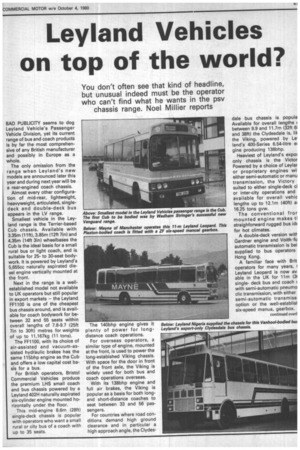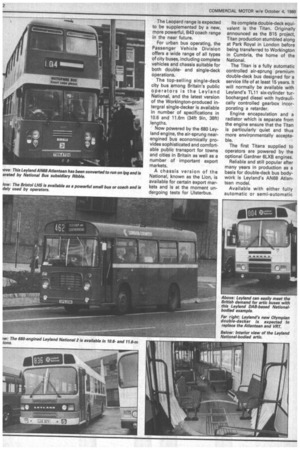Leyland Vehicles on top of the world?
Page 43

Page 44

Page 45

If you've noticed an error in this article please click here to report it so we can fix it.
You don't often see that kind of headline, but unusual indeed must be the operator who can't find what he wants in the psv chassis range. Noel Millier reports
BAD PUBLICITY seems to dog Leyland Vehicle's Passenger Vehicle Division, yet its current range of bus and coach products is by far the most comprehensive of any British manufacturer and possibly in Europe as a whole.
The only omission from the range when Leyland's new models are announced later this year and during next year will be a rear-engined coach chassis.
Almost every other configuration of mid-rear, lightweight, heavyweight, articulated, singledeck and double-deck bus appears in the LV range.
Smallest vehicle in the Leyland range is the Terrier-based Cub chassis. Available with 3.35m (lift), 3.85m (12ft 71n) and 4.35m (14ft 3in) wheelbases the Cub is the ideal basis for a small rural bus or light coach, and is suitable for 25to 30-seat body work. It is powered by Leyland's 5,655cc naturally aspirated diesel engine vertically mounted at the front.
Next in the range is a wellestablished model not available to UK operators but still popular in export markets — the Leyland FF1100 is one of the cheapest bus chassis around, and is avail able for coach bodywork for between 32 and 55 seats within overall lengths of 7.8-9.7 (25ft 7in to 30ft) metres for weights of up to 11,167kg (11 tons).
The FF1100, with its choice of air-assisted and vacuum-as sisted hydraulic brakes has the same 115bhp engine as the Cub and offers a low capital cost basis for a bus.
For British operators, Bristol Commercial Vehicles produce the premium LHS small coach and bus chassis powered by a Leyland 402H naturally aspirated six-cylinder engine mounted horizontally under the floor.
This mid-engine 8.6m (28ft) single-deck chassis is popular with operators who want a small rural or city bus of a coach with up to 35 seats. The 140bhp engine gives it plenty of power for longdistance coach operations.
For overseas operators, a similar type of engine, mounted at the front, is used to power the long-estabished Viking chassis. With space for the door in front of the front axle, the Viking is widely used for both bus and coach operations overseas.
With its 138bhp engine and full air brakes, the Viking is popular as a basis for both longand short-distance coaches to seat between 33 and 56 passengers.
For countries where road conditions demand high ground clearance and in particular a high approach angle, the Clydes
dale bus chassis is popula Available for overall lengths between 9.9 and 11.7m (32ft 6i and 38ft) the Clydesdale is, HI, the Viking, powered by Le' land's 400-Series 6.54-litre ei gine producing 138bhp.
Heaviest of Leyland's expoi only chassis is the Victor Powered by a choice of Leylar or proprietary engines wi either semi-automatic or manu transmission, the Victory suited to either single-deck ci or inter-city operations and available for overall vehic lengths up to 12.1m (40ft) al 16.25 tons gvw.
The conventional fror mounted engine makes ti straighforward rugged bus id( for hot climates.
A double-deck version witF Gardner engine and Voith fu automatic transmission is bei supplied to bus operators Hong Kong.
A familiar face with Brit operators for many years, I Leyland Leopard is now av. able in the UK for 11m (31 singledeck bus and coach I with semi-automatic pneumo clic transmission, with either semi-automatic transmiss option or the well-establisl six-speed manua, gearbox. The Leopard range is expected to be supplemented by a new, more powerful, 843 coach range in the near future.
For urban bus operating, the Passenger Vehicle Division offers a wide range of all types of city buses, including complete vehicles and chassis suitable for both doubleand single-deck operations.
The top-selling single-deck city bus among Britain's public operators is the Leyland National, and the latest version of the Workington-produced intergral single-decker is available in number of specifications in 10.6 and 11.6m (34ft 9in, 38ft) lengths.
Now powered by the 680 Leyland engine, the air-sprung nearengined bus economically provides sophisticated and comfortable public transport for towns and cities in Britain as well as a number of important export markets.
A chassis version of the National, known as the Lion, is available for certain export markets and is at the moment undergoing tests for Ulsterbus. Its complete double-deck equivalent is the Titan. Originally announced as the B15 project, Titan production stumbled along at Park Royal in London before being transferred to Workington in Cumbria, the home of the National.
The Titan is a fully automatic controlled air-sprung premium double-deck bus designed for a service life of at least 15 years. It will normally be available with Leyland's TL11 six-cylinder turbocharged diesel with hydraulically controlled gearbox incorporating a retarder.
Engine encapsulation and a radiator which is separate from the engine ensure that the Titan is particularly quiet and thus more environmentally acceptable.
The first Titans supplied to operators are powered by the optional Gardner 6LXB engines.
Reliable and still popular after many years in production as a basis for double-deck bus bodywork is Leyland's AN68 Atlanteen model.
Available with either fully automatic or semi-automatic controlled epicyclic transmission, the leaf-spring chassis can take 9.5 or 10m (31ft or 33ft) double-deck bodywork.
The Atlantean is powered by Leyland's trusted 680 11.1-litre naturally aspirated engine.
Meeting the demand for operators requiring a low height double-deck bus chassis with proprietary bodyguard is the Bristol VRT3 rear-engined double-deck bus chassis.
Available for 9.3m or 10m (30ft 7in or 32ft 11in) bodywork, the VRT is powered by the Gardner 6LXB naturally aspirated six-cylinder engine coupled to a close ratio fully automatic five-speed epicyclic gearbox.
Leyland's new Olympian double-deck bus chassis, which will eventually replace both the Atlantean and the Bristol VRT3 chassis, has many Titan components.
The Olympian which will be built at the Bristol plant has a steel fabricated perimeter frame, and rear axle, rear suspension, transmission and engine options are all similar to those used in the Titan. But, unlike the Titan's independent system, the Olympian's front suspension consists of a new suspension/axle unit designed for a 7.1-tonne (7-ton) front-axle loading.
Each wheel is carried on a stub axle mounted on a conventional kingpin which is in turn carried in an l-section steel beam fastened to two trailing taper leaf links mounted on the underside.
The air-sprung Olympian will be available in both leftand right-hand drive forms and should offer all the advantages of the quiet and comfortable low floor Titan.
Articulated buses are becoming an increasingly important part of many urban transport systems worldwide, are now to be legalised in Britain.
Leyland Vehicles' range includes articulated bus chassis built by the company's wholly owned Danish subsidiary DAB.
The chassis has the engine mounted amidships and the trailer axle steered through the vehicle's central turntable.
It is available with Leyland's turbocharged 690 engine or a Swiss Saurer unit coupled to a choice of ZF HP500, Voith D851 or Allison fully automatic gearboxes, or the Leyland semi-automatic unit.
British articulated buses are likely to be restricted somewhat because of the high initial cost and the excessive amount of
road and garage space demanded by17.6m (58 f t) vehicles.
But Leyland Vehicles are well placed to meet this limited demand and have already built articulated buses for British operations by using Leyland National body components.
A current order for Leyland DABs for British Airways is being bodied at Leyland group bodybuilder Charles Roe of Leeds, using •Leyland National produced parts.
In conjunction with the National Bus Company, LV controls Bus Manufacturers Ltd which as well as owning Roes, Eastern Coachworks of Lowes
toft, Leyland National Ltd, a Bristol Commercial Vehicles.
The group is therefore in enviable position of being al to supply the needs of p senger transport operatc everywhere, and it will be eN. more versatile in a few moo time when exciting new chat developments will enter full p duction.
The range outlined here ■ then be supplemented by n coaches at first intended supplement the Leopard rai to allow LV to maintain its lit share of the total British market and to continue to be top exporter of but throughout the world.












































































































